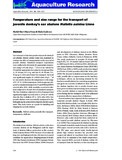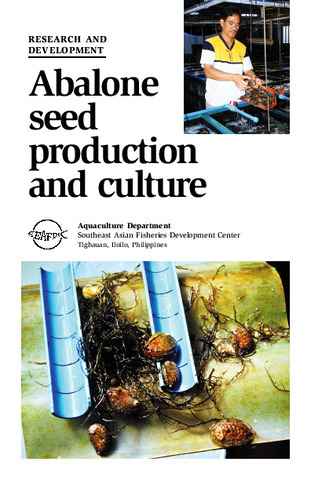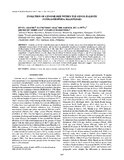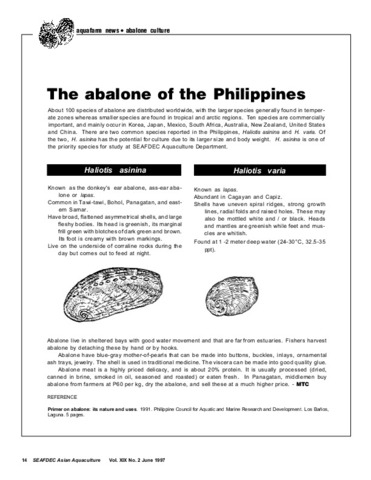Temperature and size range for the transport of juvenile donkey's ear abalone Haliotis asinina Linne
Share
Abstract
Live transport of hatchery-produced juvenile donkey's ear abalone Haliotis asinina Linne was examined to evaluate the effect of transportation on the survival of juvenile abalone. Simulated transport experiments were conducted to determine the appropriate temperature using 5, 10 and 20 g L−1 of ice to air volume for 8 h and the appropriate size using two size groups (Size A, 15–20 mm, 0.5–1.3 g, and Size B, 30–35 mm, 5.3–8.5 g) up to 24-h out-of-water live transport. Survival was significantly higher (P<0.001) when 10 g L−1 of ice was used to decrease the temperature to the range of 17–23 °C. At this temperature, both size groups subjected to simulated transport for 8 and 10 h had 100% survival after 48 h, while mortality occurred in abalones subjected to 16 and 24 h of simulated transport. The Size B abalone subjected to 24 h of transport had significantly higher survival (64.4 ± 2.9%) (P<0.001) than the Size A abalone (5.5 ± 1.6%) after 48 h. Live juvenile abalone were successfully transported to the field applying the protocols developed in the lab experiment. This study serves as a guide for handling and shipping live juvenile abalone.
Suggested Citation
Buen-Ursua, S. M. A., & Ludevese, G. (2011). Temperature and size range for the transport of juvenile donkey's ear abalone Haliotis asinina Linne. Aquaculture Research , 42(8), 1206-1213. https://doi.org/10.1111/j.1365-2109.2010.02712.x
Subject
Collections
- AQD Journal Articles [1249]
Related items
Showing items related by title, author, creator and subject.
-
Abalone seed production and culture
Unknown author (Aquaculture Department, Southeast Asian Fisheries Development Center, 2000)Details the research conducted at AQD for the tropical abalone Haliotis asinina. AQD has developed the rudiments of a hatchery protocol. -
Evolution of genome size within the genus Haliotis (Vetigastropoda: Haliotidae)
Adachi, Kenta; Arai, Katsutoshi; de la Peña, Milagros R.; Moriyama, Shunsuke; Okumura, Sei-Ichi (National Shellfisheries Association, 2018)Genome size (C-value) and the percentage of adenine and thymine nucleotides in the genome (AT content) are fundamental characteristics of every species, and very important parameters in molecular cytogenetic and phylogenic ... -
The abalone of the Philippines
Castaños, Milagros T. (Aquaculture Department, Southeast Asian Fisheries Development Center, 1997)





